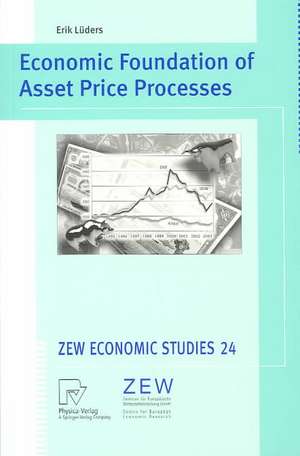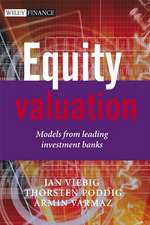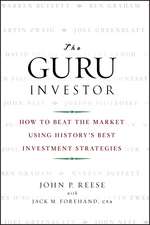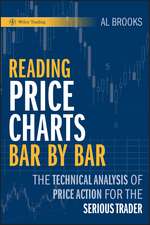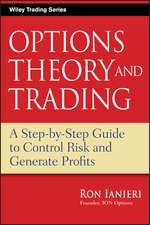Economic Foundation of Asset Price Processes: ZEW Economic Studies, cartea 24
Autor Erik Paul Lüdersen Limba Engleză Paperback – 3 feb 2004
Din seria ZEW Economic Studies
-
 Preț: 394.87 lei
Preț: 394.87 lei - 15%
 Preț: 644.18 lei
Preț: 644.18 lei -
 Preț: 379.30 lei
Preț: 379.30 lei -
 Preț: 387.75 lei
Preț: 387.75 lei - 15%
 Preț: 638.57 lei
Preț: 638.57 lei -
 Preț: 389.88 lei
Preț: 389.88 lei -
 Preț: 379.48 lei
Preț: 379.48 lei -
 Preț: 381.43 lei
Preț: 381.43 lei -
 Preț: 381.81 lei
Preț: 381.81 lei -
 Preț: 382.57 lei
Preț: 382.57 lei -
 Preț: 387.96 lei
Preț: 387.96 lei -
 Preț: 379.86 lei
Preț: 379.86 lei - 15%
 Preț: 643.34 lei
Preț: 643.34 lei -
 Preț: 390.25 lei
Preț: 390.25 lei - 15%
 Preț: 640.55 lei
Preț: 640.55 lei -
 Preț: 382.18 lei
Preț: 382.18 lei -
 Preț: 385.84 lei
Preț: 385.84 lei - 15%
 Preț: 645.28 lei
Preț: 645.28 lei - 15%
 Preț: 640.88 lei
Preț: 640.88 lei -
 Preț: 386.61 lei
Preț: 386.61 lei -
 Preț: 380.07 lei
Preț: 380.07 lei - 15%
 Preț: 644.63 lei
Preț: 644.63 lei -
 Preț: 389.70 lei
Preț: 389.70 lei - 18%
 Preț: 945.79 lei
Preț: 945.79 lei - 15%
 Preț: 640.88 lei
Preț: 640.88 lei -
 Preț: 383.33 lei
Preț: 383.33 lei - 15%
 Preț: 638.11 lei
Preț: 638.11 lei - 15%
 Preț: 639.25 lei
Preț: 639.25 lei -
 Preț: 385.62 lei
Preț: 385.62 lei -
 Preț: 384.86 lei
Preț: 384.86 lei - 15%
 Preț: 638.57 lei
Preț: 638.57 lei - 15%
 Preț: 633.68 lei
Preț: 633.68 lei -
 Preț: 384.86 lei
Preț: 384.86 lei - 15%
 Preț: 635.15 lei
Preț: 635.15 lei - 15%
 Preț: 653.98 lei
Preț: 653.98 lei - 15%
 Preț: 636.30 lei
Preț: 636.30 lei -
 Preț: 382.18 lei
Preț: 382.18 lei - 15%
 Preț: 639.41 lei
Preț: 639.41 lei -
 Preț: 382.57 lei
Preț: 382.57 lei - 15%
 Preț: 639.59 lei
Preț: 639.59 lei -
 Preț: 389.49 lei
Preț: 389.49 lei - 15%
 Preț: 646.30 lei
Preț: 646.30 lei - 15%
 Preț: 638.43 lei
Preț: 638.43 lei - 15%
 Preț: 639.08 lei
Preț: 639.08 lei -
 Preț: 383.71 lei
Preț: 383.71 lei -
 Preț: 382.75 lei
Preț: 382.75 lei
Preț: 632.70 lei
Preț vechi: 744.35 lei
-15% Nou
Puncte Express: 949
Preț estimativ în valută:
121.08€ • 125.95$ • 99.96£
121.08€ • 125.95$ • 99.96£
Carte tipărită la comandă
Livrare economică 14-28 aprilie
Preluare comenzi: 021 569.72.76
Specificații
ISBN-13: 9783790801491
ISBN-10: 3790801496
Pagini: 136
Ilustrații: XII, 121 p. 8 illus.
Dimensiuni: 155 x 235 x 7 mm
Greutate: 0.2 kg
Ediția:Softcover reprint of the original 1st ed. 2004
Editura: Physica-Verlag HD
Colecția Physica
Seria ZEW Economic Studies
Locul publicării:Heidelberg, Germany
ISBN-10: 3790801496
Pagini: 136
Ilustrații: XII, 121 p. 8 illus.
Dimensiuni: 155 x 235 x 7 mm
Greutate: 0.2 kg
Ediția:Softcover reprint of the original 1st ed. 2004
Editura: Physica-Verlag HD
Colecția Physica
Seria ZEW Economic Studies
Locul publicării:Heidelberg, Germany
Public țintă
ResearchCuprins
1 Introduction.- 2 Arbitrage-Free Markets and the Pricing Kernel.- 2.1 Implications of Arbitrage-Free Markets.- 2.2 The Representative Agent Economy.- 2.3 Summary of Chapter 2.- 3 The Information Process.- 3.1 Characterization of the Economy.- 3.2 Complete Information and Constant Coefficients of the Book Value Process.- 3.3 Complete Information and Random Coefficients of the Book Value Process.- 3.4 Unknown Drift of the Book Value Process.- 3.5 Summary of Chapter 3.- 4 Literature Review.- 4.1 Empirical Literature.- 4.2 Theoretical Literature.- 4.3 Summary of Chapter 4.- 5 Asset Returns with Non-Constant Elasticity of the Pricing Kernel.- 5.1 Implications for Asset Returns in Continuous-Time.- 5.2 Implications for Asset Returns in Discrete-Time.- 5.3 The Explanatory Power of Multiples.- 5.4 Summary of Chapter 5.- 6 Analytical Asset Price Processes.- 6.1 A New Class of Pricing Kernels.- 6.2 HARA-Preferences.- 6.3 Summary of Chapter 6.- 7 Asset Returns Given Stochastic Volatility of the Information Process.- 7.1 The Model.- 7.2 Summary of Chapter 7.- 8 Summary.- A Appendix.- A.1 Theorem of Feynman-Kac.- A.2 Lemma 2 of Decamps and Lazrak.- A.3 Technical Discussion of Viability in Two-Factor Models.- A.4 Proof of Lemma 1.- A.5 Proof of Corollary 1.- A.6 Proof of Proposition 4.- A.7 Derivation of Equation 6.3.- A.8 Proof of Proposition 8.- A.9 Derivation of Equation 6.17.- A.10 Proof of Corollary 2.- A.11Proof of Proposition 9.- A.12 Proof of Proposition 10.- B Appendix: Figures.- References.
Textul de pe ultima copertă
In this book the relation between the characteristics of investors' preferences and expectations and equilibrium asset price processes are analysed. It is shown that declining elasticity of the pricing kernel can lead to positive serial correlation of short term asset returns and negative serial correlation of long term returns. Analytical asset price processes are also derived. In contrast to the widely used "empirical" time-series models these processes do not lack a sound economic foundation. Moreover, in contrast to the popular Ornstein Uhlenbeck process and the Constant Elasticity of Variance model the proposed stochastic processes are consistent with a classical representative investor economy.
